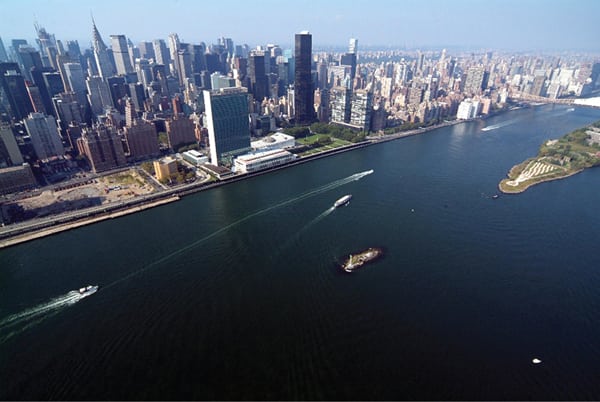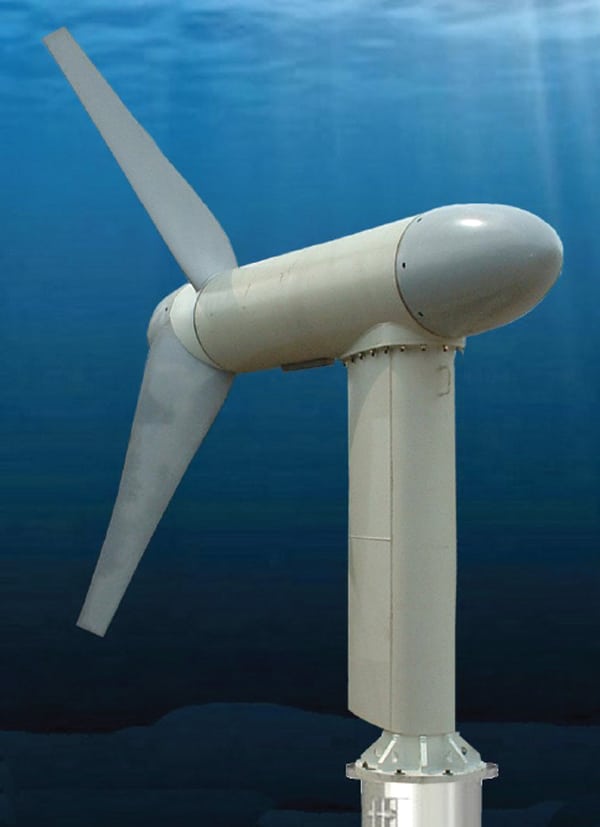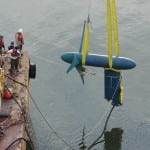The Roosevelt Island Tidal Energy (RITE) pilot project used six full-scale hydrokinetic turbines to capture the power of river tides and currents and convert it into electricity. Located in New York City’s East River, it is the first and only grid-connected tidal array project in the world. RITE project developers are seeking approval to install up to 30 additional turbines in the near future.
The multi-phase Roosevelt Island Tidal Energy (RITE) project is making waves in the renewable energy sector. New York–based Verdant Power Inc. launched the RITE project in an effort to commercialize its kinetic hydropower “Free Flow System,” which deploys three-bladed turbines in fast-moving tides and rivers to generate energy.
Through the RITE Project Phase 2 Demonstration, which lasted from 2006 through 2008, Verdant Power proved that the 4th Generation (Gen4) Free Flow System could function successfully as an efficient source of renewable energy. Using six full-scale turbines, the system delivered 80 MWh of grid-connected energy from the tides of the East River to New York City customers with no power quality problems (Figure 1).
 |
| 1. Powering the Big Apple. The RITE pilot project deployed hydrokinetic turbines in the East River. During the implementation phase, Verdant Power worked with Con Edison to interconnect the array with its distribution system so New York City customers could receive power from tidal energy. The tip of Roosevelt Island appears on the far right. Courtesy: Verdant Power Inc. |
In March, POWER interviewed Trey Taylor, Verdant Power’s cofounder and president, and Aaron Hernandez, assistant to company cofounder and CEO, Ronald Smith.
Preparations for the RITE Phase 3 build-out are now under way. They began with Verdant Power’s submission of an application for a pilot license to the Federal Energy Regulatory Commission (FERC) in December 2010, Taylor said. If granted, this license would allow Verdant Power to build out the RITE Project in the East Channel of the East River to a 1-MW, 30-turbine Generation 5 (Gen5) Free Flow System and to commercially deliver the energy generated by the field to local customers. The RITE Phase 3 project is expected to generate an average of up to 2,400 MWh annually.
“The local residents on Roosevelt Island have stated that ‘they want this power project in their backyard!’” Taylor told POWER. “Residents refer to the area surrounding the East River of New York City as ‘Asthma Alley.’ They know that the RITE Project is a start at cleaning up this reach of the river and section of the city.”
How Hydrokinetic Systems Work
The hydrokinetic systems used by Verdant Power employ underwater turbines to generate clean energy from the currents of tides, rivers, and manmade channels (Figures 2, 3, and 4). The systems are invisible from shore.
 |
| 2. Preparing the pilot project. The workers shown were involved in initial stages of the RITE project’s Phase 2, which lasted from 2006 through 2008. With this project, Verdant Power proved that its 4th Generation Free Flow System could function successfully as an efficient source of renewable energy. Courtesy: Christopher R. Gray/Verdant Power Inc. |
 |
| 3. Heave ho. Verdant Power workers prepared the turbine for installation in the East River. Because hydrokinetic systems do not require dams, impoundments, or other major civil works, they have minimal public and environmental impact and lower upfront capital costs. Courtesy: Kris Unger/Verdant Power Inc. |
 |
| 4. Come on in, the water’s fine. The turbine was moved to the location in the East River, where it was later installed underwater. In river schemes, hydrokinetic turbines can provide dispatchable power due to high capacity factors estimated to range between 60% and 70% day and night. Courtesy: Christopher R. Gray/Verdant Power Inc. |
Simple and modular in design, the systems can be scaled to produce cost-effective power at a wide variety of sites, including directly within population centers. The few moving parts of the systems also decrease operation and maintenance costs. Additionally, because the systems do not require dams, impoundments, or other major civil works, they cause minimal public and environmental impact and have lower upfront capital costs‚ an aspect that makes them especially suitable for use in developing countries.
Water currents provide a predictable, if not constant, source of renewable energy. This creates an advantage for hydrokinetic technologies over wind and solar systems, which offer intermittent power that is more subject to daily changes in weather and blackout scenarios.
“Verdant Power anticipates that its river-based systems will eventually achieve 60% to 70% capacity factors, approximately double those of wind and solar power systems,” Taylor said.
Project Overview
Though a few other companies have installed single hydrokinetic units, the completed RITE Phase 2 remains the first and only grid-connected tidal array project in the world, Taylor pointed out.
The U.S. Department of Energy (DOE) provided partial funding for the Gen5 advancement, specifically the design and testing of a new composite turbine blade in partnership with the DOE’s National Renewable Energy Laboratory (NREL), Sandia National Laboratories, and the University of Minnesota’s St. Anthony Falls Laboratory, Hernandez said. Major funding for development of the RITE Project was provided by the New York State Energy Research and Development Authority and the New York City Economic Development Corp.
“Verdant Power received a special FERC ruling named the ‘Verdant Ruling,’ which allows hydrokinetic companies to be grid-connected during testing periods only,” he said. “As a result, our company worked with Con Ed to interface with its distribution system in order for Verdant Power customers to receive tidal energy in a seamless fashion. As a source of distributed energy, tidal power is very reliable and highly predictable.”
Verdant Power’s Gen5 hydrokinetic turbine has been optimized for cost-effective commercial manufacturing, environmental compatibility, and longevity. The new blades are manufactured using a composite (FRP) material and are readily scalable for use in a variety of tidal and river settings (Figure 5). In addition to these improvements, the Gen5 turbine includes the following features:
- A ductile iron hub casting.
- Integrated gearbox unit incorporating shaft housing/bearings/seals.
- A failsafe brake.
- Redundant dynamic (shaft) and static sealing.
- Nontoxic fouling-release coating system.
- An improved commercial quality-control and -assurance manufacturing process.
 |
| 5. Going with the flow. The new blades are manufactured from a composite (FRP) material and are readily scalable for use in a variety of tidal and river settings. Courtesy: Verdant Power Inc. |
The turbines can provide baseload power, and in river schemes, they could provide dispatchable power due to high capacity factors estimated to range between 60% and 70% day and night, Taylor said. The turbine includes a failsafe brake, which is automatically applied upon any failure of the generator, cable, control system, interconnection, or the electrical grid itself. The brake can also be manually applied via a remote signal from shore that cuts power to any generator. This mode is useful during commissioning testing and for maintenance operations.
The project is designed to operate unattended. Servicing and repair will be handled by removing each turbine from its gravity-based anchoring frame, replacing it with a new turbine, and bringing the old turbine ashore for repair, maintenance, upgrade, and recycling. The timing and support staffing for servicing activities will be optimized on a site-by-site basis. The projected life span of the East River turbines will range from 20 to 25 years, assuming five-year maintenance intervals.
RITE Project Financial Issues
Total projected cost for construction and installation of the 1-MW Phase 3 will range between $18 million and $20 million, Taylor said. Future projects are expected to cost one-half to one-third of that—even less for projects outside the U.S.
As for estimated electricity costs, Taylor said, “The cost to generate hydrokinetic power will range between 6 cents and 10 cents per kWh. This compares favorably to coal, which is at about the same range of costs.”
Verdant Power Inc. management currently is working on lining up a buyer for the electricity generated by its U.S. project. The company is encouraged by the fact that several hydrokinetic projects overseas are having good success selling their energy.
“For our RITE Project in New York City, we are still in discussions regarding the purchase of generated energy,” Taylor said. “For tidal turbines, which are being tested at the European Marine Energy Centre in the Orkneys, ScottishPower is buying that energy. And for the Marine Current Turbines project in Strangford Lough, Ireland’s ESB Independent Energy is buying that energy.”
Advantages of the East River Location
Taylor explained that the East Channel of New York City’s East River is particularly advantageous because of its strong tidal currents and the good capacity factor (30%) that it enables. Furthermore, deep draft vessels use the West Channel of the East River, so navigational issues were not a problem for the RITE Phase 2 project.
“There is potential for as much as 10 MW in the East River,” he said. “However, navigational issues must be taken into account if the project is to expand beyond the current 1 MW planned installation. No timeline is in place for this potential additional capacity.”
He added that the only technical challenges remaining for the East River location—as for all locations—will be to find cost-effective ways to deploy and retrieve hydrokinetic systems for maintenance.
Fluctuations in the flow of the river due to low rainfall or flooding conditions do not affect the RITE project. Taylor explained that “the East River is a tidal channel and therefore is not affected.” Verdant Power management selects rivers after thorough resource assessments take into account variables such as seasonal fluctuations.
Dealing with Environmental and Security Concerns
“After multiple years of monitoring using state-of-the-art hydroacoustic and sonar systems, empirical evidence showed that the six installed turbines (RITE Project, Phase 2 demonstration) had minimal environmental impacts” on birds and fish, Taylor said. “Additional monitoring will be conducted during the staged development of the 1-MW pilot project to study any impacts caused by a larger array.”
He explained that moving the proposed Phase 3 project forward will require approvals at the federal, state, and city levels. If granted, these approvals will outline operating parameters, including comprehensive plans for environmental monitoring to be conducted throughout the staged development of the project.
As for security, the turbines are equipped with sensors that can be read in real time from around the world, Taylor said. In addition, because the turbines are underwater and cannot be seen, there is little concern about security challenges. He pointed out that “signs are posted and buoys anchored around the turbine fields advising recreational craft to stay clear of the area.”
Upbeat Downstream Projections
Verdant Power has plans to develop more sites. However, in a cautionary comment, Taylor pointed out that his company may have to go outside of the U.S. to advance its technologies, “because the economic incentives do not yet exist in the U.S. to meet the industry’s needs.”
Nonetheless, he is optimistic that the tide is beginning to rise for hydrokinetic energy. For example, he described how the RITE project could provide power to the grid for electric vehicle charging stations, thereby lessening greenhouse gas emissions. Furthermore, hydrokinetic turbines will create jobs in manufacturing, assembly, deployment, retrieval, service, and maintenance, according to Taylor: “It is estimated that for every 1 GW of hydrokinetic turbines produced, more than 1,500 full time jobs will be created.”
“Hydrokinetic energy, both bidirectional (tidal) and unidirectional (river and manmade channels), could provide at least 12 GW of installed capacity for the U.S. within the next 10 years, provided the licensing and permitting processes are streamlined,” he said. “Longer term, the installed capacity could be in excess of 60 GW, given the advances in hydrokinetic technologies.”
— Angela Neville, JD, is senior editor of POWER.









